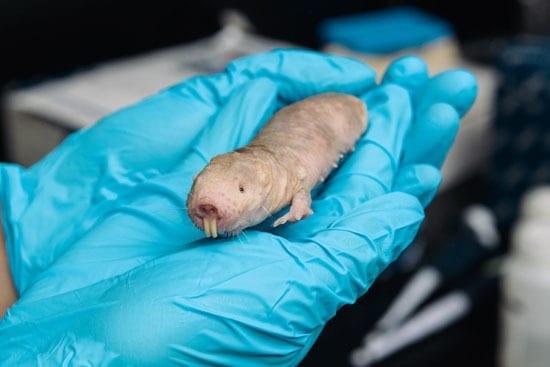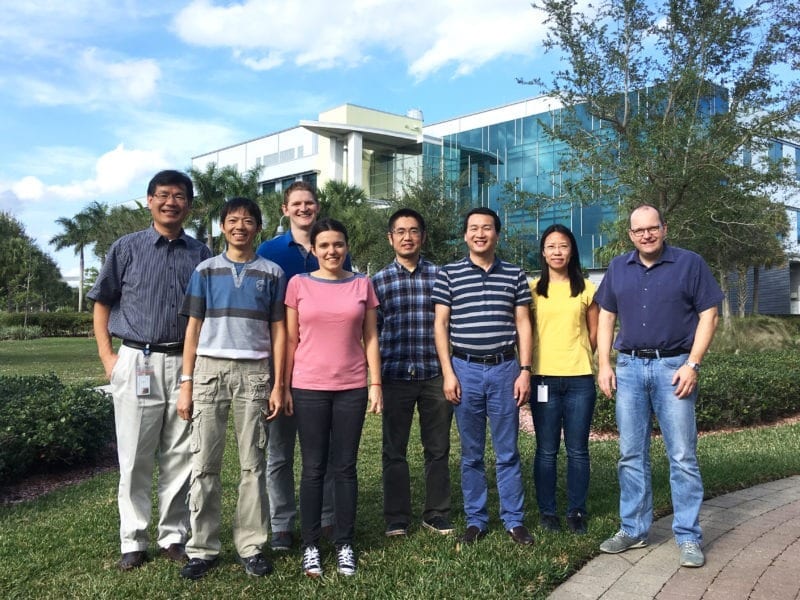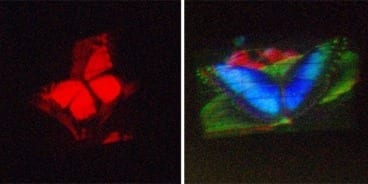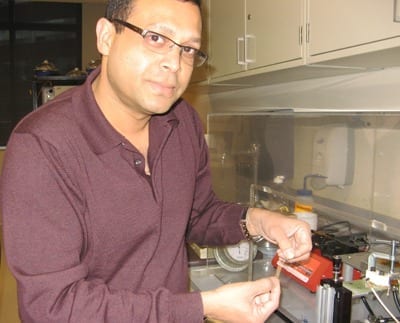
Two researchers at the University of Rochester have discovered the chemical that makes naked mole rats cancer-proof.
Their research paper is being published today in the journal Nature.
The findings could eventually lead to new cancer treatments in people, said study authors Andrei Seluanov and Vera Gorbunova.
Naked mole rats are small, hairless, subterranean rodents that have never been known to get cancer, despite having a 30-year lifespan. The research group led by Seluanov and Gorbunova discovered that these rodents are protected from cancer because their tissues are very rich with high molecular weight hyaluronan (HMW-HA).
The biologists’ focus on HMW-HA began after they noticed that a gooey substance in the naked mole rat culture was clogging the vacuum pumps and tubing. They also observed that, unlike the naked mole rat culture, other media containing cells from humans, mice, and guinea pigs were not viscous.
“We needed to understand what the goo was,” said Seluanov.
Gorbunova and Seluanov identified the substance as HMW-HA, which caused them to test its possible role in the naked mole rat’s cancer resistance.
Seluanov and Gorbunova then showed that when HMW-HA was removed, the cells became susceptible to tumors, confirming that the chemical did play a role in making naked mole rats cancer-proof. The Rochester team also identified the gene, named HAS2, responsible for making HMW-HA in the naked mole rat. Surprisingly, the naked mole rat gene was different from HAS2 in all other animals. In addition naked mole rats were very slow at recycling HMW-HA, which contributed to the accumulation of the chemical in the animals’ tissues.
The next step will be to test the effectiveness of HMW-HA in mice. If that test goes well, Seluanov and Gorbunova hope to try the chemical on human cells. “There’s indirect evidence that HMW-HA would work in people,” said Seluanov. “It’s used in anti-wrinkle injections and to relieve pain from arthritis in knee joints, without any adverse effects. Our hope is that it can also induce an anti-cancer response.”
“A lot of cancer research focuses on animals that are prone to cancer,” said Gorbunova. “We think it’s possible to learn strategies for preventing tumors by studying animals that are cancer-proof.”
The Latest Bing News on:
Cancer Resistance
- Unraveling the link between the microbiome and esophageal canceron May 9, 2024 at 10:23 am
Esophageal cancer (EC) is an aggressive malignancy with a poor prognosis, with its development and progression potentially influenced by changes in the esophageal microbiome. Recent studies have ...
- A global effort to fight antibiotic resistanceon May 9, 2024 at 8:52 am
In November 2017, days after her daughter Mallory Smith died from a drug-resistant infection at the age of 25, Diane Shader Smith typed a password into Mallory’s laptop. Her daughter gave it to her ...
- Cancer: Here's the role exercise plays, from prevention to treatmenton May 9, 2024 at 8:48 am
Cancer is the second leading cause of death worldwide. In Europe, almost 3 in every 10 adults were diagnosed with a form of cancer in 2022.
- Intermittent fasting halts liver disease progression and reduces cancer riskon May 8, 2024 at 11:13 pm
Fatty liver disease often leads to chronic liver inflammation and can even result in liver cancer. Scientists from the German Cancer Research Center (DKFZ) and the University of Tübingen have now ...
- Researchers identify what drives PARP inhibitor resistance in advanced breast canceron May 8, 2024 at 1:13 pm
Researchers at The Institute of Cancer Research, London, have increased our understanding of how a cancer drug called a PARP inhibitor stops working in women with breast cancer that has spread. This ...
- Oncolytic Viruses: A Promising New Option in Cancer Treatmenton May 8, 2024 at 7:59 am
As part of its Speaking Out video series, Targeted Oncology spoke with Howard D. Edington, MD, about the benefits of using oncolytic viruses in cancer treatment.
- Can Vitamin D Improve Cancer Immunotherapy?on May 8, 2024 at 6:30 am
Your diet could impact your cancer treatment’s progress; a new preclinical study suggests more vitamin D could improve responses to checkpoint inhibitors.
- Alabama aims to eliminate cervical cancer in a decadeon May 7, 2024 at 11:33 am
Health professionals in Alabama strive to eradicate cervical cancer within a decade, as rates continue to rise in certain demographics.
- Dogma-challenging telomere findings may offer new insights for cancer treatmentson May 7, 2024 at 2:00 am
A new study led by University of Pittsburgh and UPMC Hillman Cancer Center researchers shows that an enzyme called PARP1 is involved in repair of telomeres, the lengths of DNA that protect the tips of ...
- Non-Coding DNA Could Explain Childhood Cancer’s Radiotherapy Resistanceon May 2, 2024 at 1:48 am
Scientists at St. Jude Children’s Research Hospital have discovered non-coding genetic variants contributing to chemotherapy resistance in acute lymphoblastic leukemia.
The Latest Google Headlines on:
Cancer Resistance
[google_news title=”” keyword=”Cancer Resistance” num_posts=”10″ blurb_length=”0″ show_thumb=”left”]
The Latest Bing News on:
Cancer treatment
- Critical funding to Victoria's world-class cancer centre cuton May 9, 2024 at 3:04 am
Treasurer Tim Pallas's 10th budget revealed medical research funding would be cut from $30.5 million to $7.5 million over four years.
- Are Much Needed Advances in Early Esophageal Cancer Detection on the Horizon?on May 9, 2024 at 3:00 am
Esophageal cancer remains plagued by a lack of effective techniques to detect early malignancies. Due to this major clinical challenge, esophageal ca | Cancer ...
- Bond with his mother Veronica, a cancer survivor, runs deep for Jaguars tackle Tyler Lacyon May 9, 2024 at 2:04 am
Jacksonville Jaguars' tackle Tyler Lacy comes from a close-knit family, with mother Veronica as the rock. A cancer survivor, she's a "hero" that inspires him.
- I Had Cancer. My Treatment Was Eye-Opening About Addictionon May 9, 2024 at 1:31 am
I've had two different types of cancer in two years and in both instances, I was screened, diagnosed early, and ushered into care.
- New, painless skin cancer treatment coming to Vanderburgh Co.on May 8, 2024 at 8:49 pm
People who suffer from skin cancer in Vanderburgh county will now have the option to go through nonsurgical, painless treatment.
- Buy Rating Affirmed on Olema Pharmaceuticals Amid Promising Breast Cancer Treatment Advances and Strategic Novartis Collaborationon May 8, 2024 at 3:45 pm
Sam Slutsky, an analyst from LifeSci Capital, maintained the Buy rating on Olema Pharmaceuticals (OLMA – Research Report). The associated ...
- Amid Kate Middleton's Cancer Treatment, 'Positive Vibes' and 'Optimistic Mood' Prevail, Close Source Says (Exclusive)on May 8, 2024 at 1:23 pm
Kate Middleton is outside of the public eye while receiving cancer treatment, but a close source says there’s a palpable sense of "positive vibes" and an "optimistic mood." All the while, Prince ...
- New blood cancer treatment on offer for Nottingham patientson May 7, 2024 at 10:14 pm
Calle, head of the new Nottingham CAR T-cell service and a consultant haematologist at Nottingham University Hospitals NHS Trust, said the treatment would help pa ...
- Professional Faqs: Is Asparagus Beneficial In The Treatment Of Cancer?on May 7, 2024 at 2:28 pm
Expert opinion from Deidre Huysamen Dietician - Dietetics and Clinical Nutrition Services · 7 years of experience · South Africa No, asparagus is not beneficial in the treatment of cancer. Asparagus ...
- King Charles III is ‘very good’ amid cancer treatment, won’t see Harry during prince’s U.K. visiton May 7, 2024 at 9:54 am
King Charles III returned to public-facing royal duties last week amid cancer treatment. A busy schedule means he can't see Prince Harry in the U.K. this week.
The Latest Google Headlines on:
Cancer treatment
[google_news title=”” keyword=”cancer treatment” num_posts=”10″ blurb_length=”0″ show_thumb=”left”]











